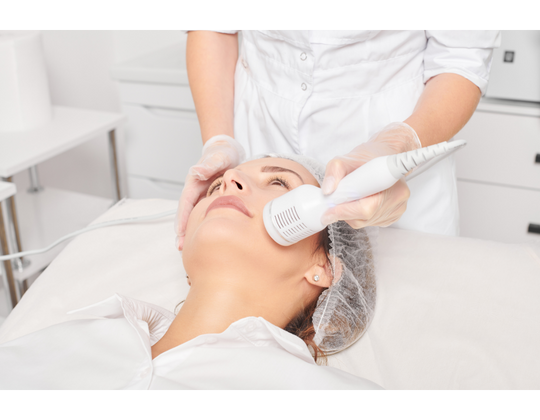
What is Cryotherapy?
Cryotherapy is used to eliminate these lesions by applying liquid nitrogen to skin lesions that are at risk of turning into malignant skin tumors or crust-like lesions that appear on the skin due to sun and age-related effects. It is the process of freezing.
How Does Cryotherapy Work?
Cryotherapy is a method based on the principle of evaporation of nitrogen gas, which is liquid at -196°C, at atmospheric pressure. When nitrogen is sprayed on the target skin area with the help of the applicator attached to the end of the liquid nitrogen tank, the liquid nitrogen evaporates rapidly and causes a sudden cooling on the skin. This causes the cells in the epidermis, the upper layer of the skin in the application area, to be damaged and to crust over and fall off.
How is Cryotherapy Done?
- First, the area where cryotherapy will be applied is determined and marked.
- Then local anesthetic cream is applied.
- Liquid nitrogen is sprayed onto the application area for 15-60 seconds with the applicator attached to the end of the liquid nitrogen tank
- The application area should not be touched after application.
What are the Advantages of Cryosurgery?
- In this superficially applied procedure, epidermal lesions can be treated with minimal damage to the area.
- With this method, a rapid recovery process is achieved.
- There is no harm in repeating this process.
- In addition to being used at all ages, the procedure can also be used safely in pregnant women.
Lesions for which Cryotherapy is the First Option
- Lentigo
- Sebaceous hyperplasia
- Lokoplakia
- Actinic keratosis
- Porokeratosis (plantar)
- Porokeratosis (actinic)
- Verruca
Lesions Where Cryotherapy is an Alternative Option
- Acrochordon
- Leiomyoma
- Angiofibroma
- Arsenic keratosis
- Sarcoidosis
- Syringoma
- Verruca plantaris
- Lupus vulgaris
- Porokeratosis (Mibelli)
- Verruca plana
- Eosinophilic granuloma
- Prurigo nodularis
- Mastocytoma
- Seborrheic keratosis
- Adenoma sebaceousum
- Molluscum contagiosum
- Acne pustules and cysts
- Silentoma
- Nevus (epithelial)
- Steatocystoma multiplex
- Lupus erythematosus
- Lentigo malignant melanoma
- Chondrodermatitis
- Ecrine poroma
- Gran&ulum;loma annulare
- Condyloma acuminata
- Elastosis perforans serpiginosis
- Pyogenic granuloma
- Rhinophima
Important Information About Cryotherapy Treatment
Seen Therefore, this method can be used for treatment purposes in many different procedures. The biggest advantages of this procedure are that it is a very simple procedure, does not cause any pain, and does not involve any financially challenging amounts.
It is quite normal to have slight redness and swelling after this procedure. Pain after the procedure is very rare, and in such cases the doctor can find a solution. It is also very easy to make a dressing after this procedure. Unlike other procedures, there is no harm in taking a shower after this procedure, and it is even recommended to do so. In this way, the existing wound will be cleaned with running water. The procedure does not prevent patients from their daily lives. Even patients, on the day of the procedure, or at most they can continue their daily lives the next day after the procedure. Wounds heal within 1 to 4 weeks, depending on their depth.


